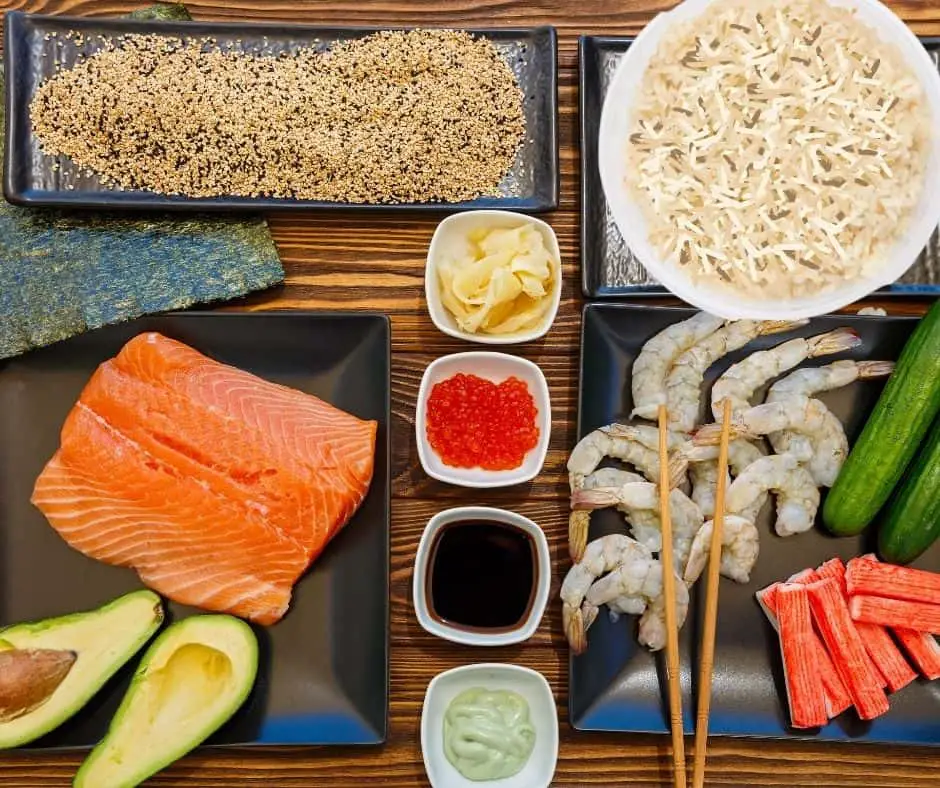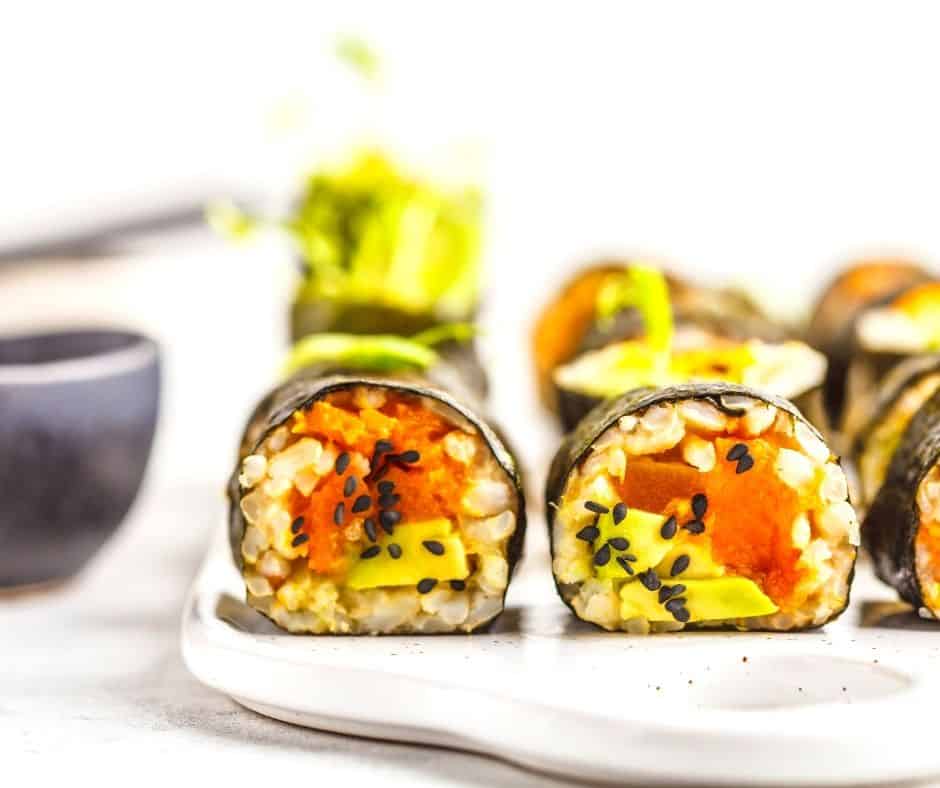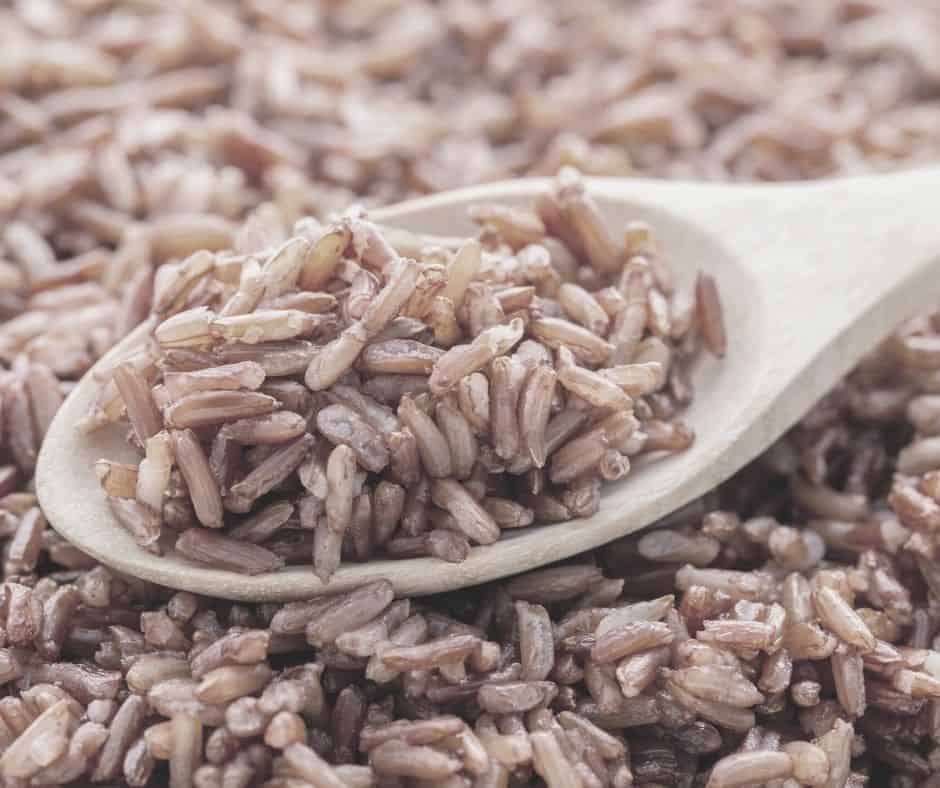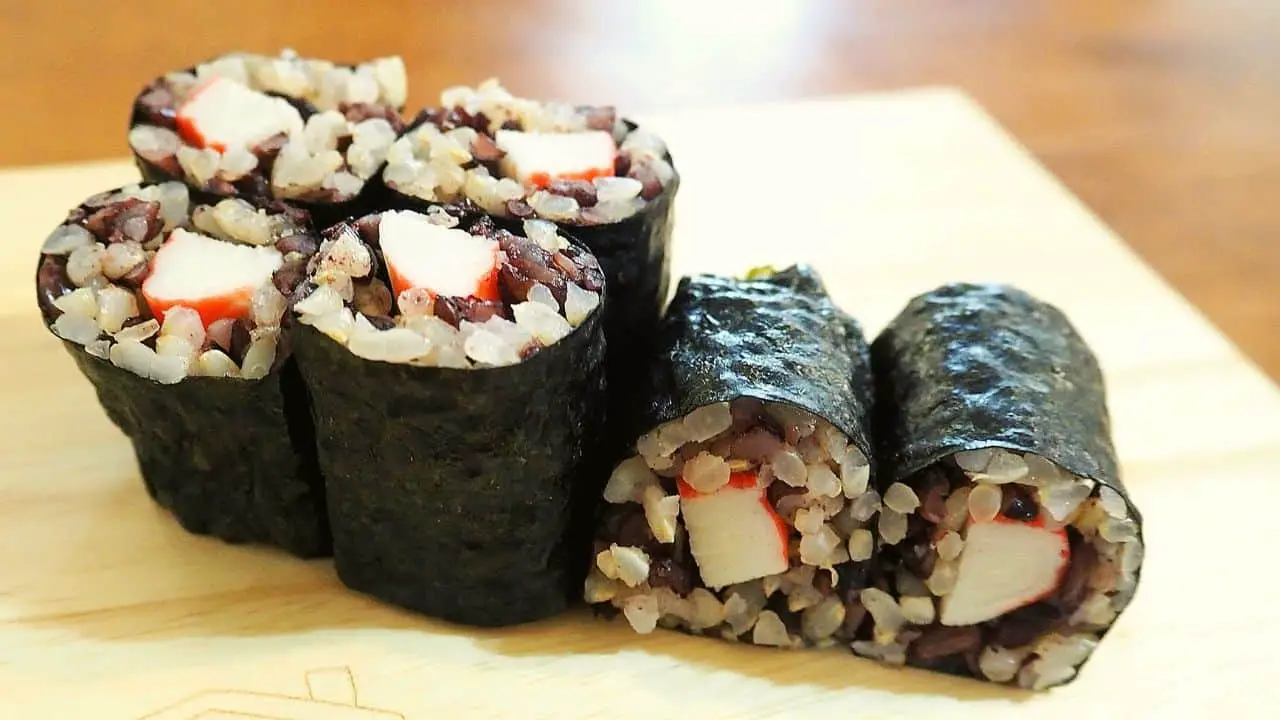Here are some practical tips on how to make brown rice sticky for sushi so you can make a perfect sushi roll.
In this post, I will go over how to cook sticky brown rice, the benefits of switching to wholegrain rice, and share some delicious sushi recipe ideas to inspire you to get cooking.
Although short-grain white rice is probably the most glutinous and, therefore, the best choice for making traditional sushi, the method described in this post can help you turn brown rice into sticky sushi rice as well.

I have successfully used short-grain, medium-grain, and long-grain brown rice to make firm and delicious sushi rolls.
You have to treat brown rice slightly differently than white sushi rice, and the taste and texture will be somewhat different. Luckily, with the right tips and tricks, you can use just about any variety of brown rice to make delicious homemade sushi.
How To Make Sticky Brown Rice Perfect For Making Sushi Rolls

1. Soak And Rinse Before Cooking
To achieve the most sticky result, soak the brown rice for 15 minutes and rinse the rice once before cooking. Unlike white sushi rice, which needs rinsing until all the starch is removed, brown rice only needs one rinse.
2. Use Less Water When Boiling
DO NOT use too much water when boiling it. Although brown rice generally needs about 50% more water to cook than white rice due to its higher fiber content, cooking it for sushi requires a different approach. The sticky gluten is rinsed away by boiling in a lot of water, so using less water results in more sticky rice.
Use the ratio of 1 cup of brown rice to 1 1/2 cups of water.
3. Boil Gently
- Put the soaked and rinsed brown rice in a saucepan and add the water.
- Bring it to a boil and then reduce the heat to a gentle simmer.
- Simmer without the lid for about 30 minutes until the rice has absorbed almost all the water.
- Taste the rice. The texture should be quite fluffy but with a slightly firm bite. If too mushy, then it is overcooked.
- Now, turn off the heat, cover it with a lid, and leave it for another 10 minutes to absorb any remaining water.
4. Add Vinegar, Sugar, And Salt
Adding vinegar, salt, and sugar will give the rice an authentic sourish taste and also make it more sticky and easier to work with.
For every 1 cup of brown rice, mix together:
- 2 tablespoons rice vinegar or apple cider vinegar
- a quarter teaspoon of Himalayan pink salt or sea salt
- 1/2 tablespoon of sugar
Heat the mixture slightly in a saucepan over low heat until the sugar has dissolved, and then using a mixing bowl, spatula, or rice paddle, gently fold it in the cooked rice. Carefully mix it till it looks sticky yet dry.
Ready-made store-bought sushi vinegar, which already includes salt and sugar, will also work, but it won’t give you a deliciously authentic result when making your own seasoning vinegar.
To really master the seasoning part, check out my latest post here: How to Season Sushi Rice? (Seasoning Ratio and Ingredients).
5. Mix Delicately
DO NOT overmix the rice or mix when the rice is too hot, as this can cause the grains to release excess starch, which will make it overly sticky and hard to manage in sushi.
6. Cool And Roll Your Sushi
Cover the bowl with a damp kitchen towel to prevent the rice from drying out. Let the rice cool for about 30 minutes till it reaches room temperature. Grab your sushi mat and roll your whole-grain sushi.
For the rice cooker version, check out the instructions in the first recipe below.
Read Also: Canned Tuna For Sushi! – Will It Work?
Is Brown Rice A Good Sushi Rice Substitute?

Most devote sushi lovers would say that you should stick to traditional short-grain white Japanese rice.
Yes, white rice is typically preferred for sushi because it provides a simple base for the flavors of the sushi fillings. The bran and germ in the brown rice result in a deeper, earthy flavor which can disturb that delicate flavor balance for many.
For many sushi lovers, the texture of brown rice is also not ideal. That is due to the different starches and sugars present. Brown rice (especially long-grain varieties) is a bit more chewy and firmer even after boiling, which can lead to a less-than-ideal feel in the mouth.
Many people love sushi because the white rice, fish, and nori blend together and allow each bite to melt in the mouth. Unfortunately, brown rice needs a lot more chewing and, therefore, may not have the same appeal.
However, as we know, brown rice can have many nutritional benefits compared to white rice, and as taste is all down to personal preference, there is no reason you can’t use wholegrain rice in sushi.
It is not traditional, but if you are someone who is looking to make an easy and nutritious ingredient swap to allow you to enjoy delicious sushi while also sticking to a healthier diet, this might just be the solution you were looking for.
If you still think that using brown rice blatantly violates the rules of a good sushi recipe, then let me share some moreish brown rice sushi recipes below that will undoubtedly change your mind.
Read Also: Important Storage Tips For Sushi – How To Keep Sushi Fresh Overnight?
5 Easy Homemade Brown Rice Sushi Recipes

1. How To Make Long Grain Brown Rice For Sushi (Rice Cooker Version)
This simple recipe goes over all the basics for creating the perfect fluffy brown rice for sushi using a rice cooker. Just add your favorite sushi fillings.
The dressing is also a bit different, using brown sugar and honey. You may find the rice becomes a little sticky, but once the rice is cool, it will become easier to manage and shape into delicious and firm sushi rolls.
Check out the full recipe on Cookstr.
2. Brown Rice Sushi Roll With Crab Sticks
This recipe goes over everything from how to cook the brown rice and the fillings and how to plate everything up. The author has even included some very detailed step-by-step photographs to ensure you know exactly what you are doing every step of the way.
This is a great recipe to try for your first taste of brown rice sushi rolls.
Check out the full recipe for Roti’ N’ Rice.
3. Chicken Teriyaki Sushi
The editors at Delish have provided us with yet another banging recipe.
This delicious and nutritious recipe is for short-grain brown rice sushi with cucumber, snow pea sprouts, and teriyaki chicken. Although this recipe may appear daunting at first, with the long ingredients list and a total of nine steps, it is surprisingly easy to follow.
With the combination of whole-grain rice and chicken as a lean protein source, this recipe would make an excellent option for a packed lunch.
The rice and chicken, coupled with the fresh vegetables, will give you long-lasting energy to see you through the rest of your working day.
Check out the full recipe on Delish.
4. Clean Eating Shrimp Sushi Roll Recipe
Brighten up your day with this colorful recipe for brown sushi rice with cooked shrimp.
This recipe will take you through each stage of the sushi preparation process to ensure you end up with a perfectly even, expertly assembled sushi roll.
Impress anyone with this recipe by using battered and fried shrimp instead of boiled shrimp for an additional crispy texture.
The recipe also uses Himalayan pink salt, which is my absolute favorite cooking salt.
Check out the full recipe on Kitrusy.
5. Classic Homemade Sushi Recipe (With Brown Rice)
Although brown rice isn’t traditionally used in sushi, you can keep things authentic with the fillings. This recipe uses classic ingredients of raw shrimp, raw tuna, avocado, and cucumber to create a beautiful Japanese-inspired dish.
If you are not a fan of shrimp or tuna, you could use cooked crab and raw salmon to achieve those iconic fishy flavors.
To take this recipe to the next level, you can top your sushi with toasted sesame seeds, wasabi, and pickled ginger.
Check out the full recipe on 100 Days of Real Food.
Benefits Of Switching To Brown Rice In Sushi

Fiber
Brown rice contains insoluble fiber that supports the movement in your digestive tract. Fiber can also help keep you feeling fuller for longer and, therefore, can help sustain energy levels and weight loss.
Manganese
Just one cup of brown rice contains 88% of your recommended daily intake of manganese. This mineral is essential for bodily functions, including bone growth, cell renewal and repair, and maintaining healthy blood sugar levels.
Choline
Choline is another essential nutrient that is present in brown rice. This nutrient will aid the transportation of certain fats from the liver to other parts of the body, therefore supporting a healthy liver.
Other Nutrients Found In Brown Rice:
- Vitamin E
- Vitamin B6
- Thiamin
- Magnesium
- Potassium
- Calcium
- Iron
- Zinc
- Folate (Vitamin B9)
- Riboflavin (Vitamin B2)
How To Store Sticky Rice And How Long Does It Last?
If you happen to make too much sticky rice or like to batch cook, don’t worry, you don’t have to use it all on the same day.
Store unseasoned white or brown sushi rice in the fridge for 4-5 days. Make sure it has cooled down to room temperature, and then store it in an airtight container at the back of the fridge.
Your other option is to freeze it. All types of sticky rice will last around 6 months when frozen.
Try not to freeze too much rice in one block; otherwise, you will be waiting for what will feel like an eternity for it to defrost. So make sure you divide it into usable portions first.
Top Tips:
- Freeze your rice in ice cube trays so you can remove precisely the amount you wish to eat per meal. This is an excellent hack for anyone who likes to make sushi every day or meal prep far in advance.
- Alternatively, you can freeze the rice in an airtight container and place a sheet of baking paper between each portioned-out layer.
Read Also: 6 Compelling Reasons To Rinse Your Rice Before Cooking!
